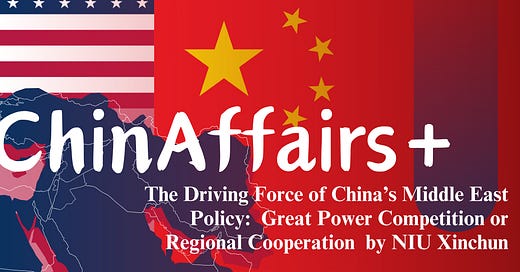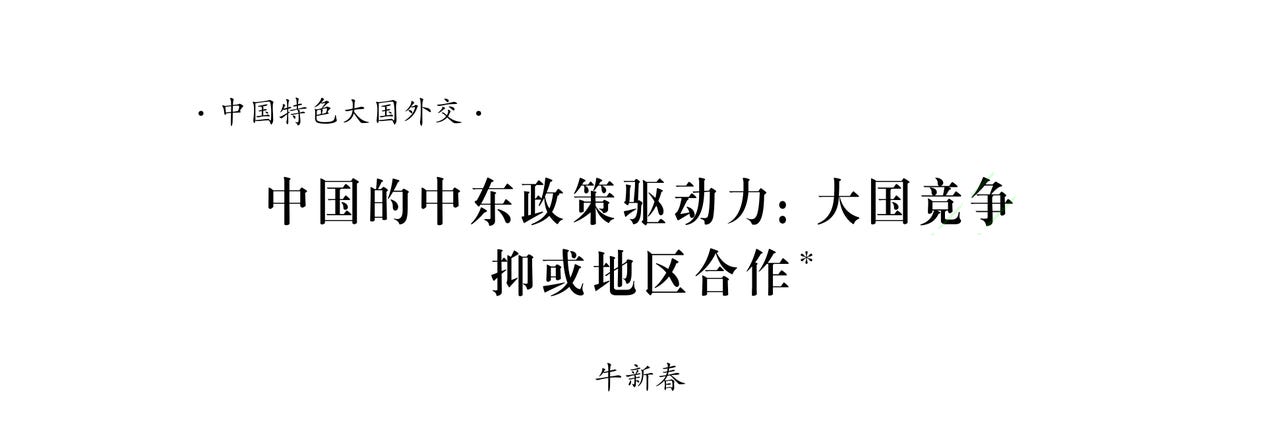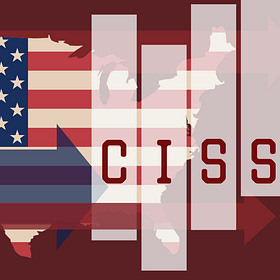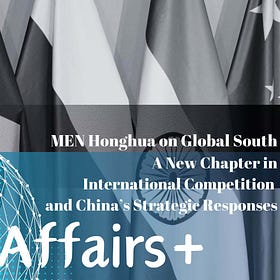The Driving Force of China’s Middle East Policy: Great Power Competition or Regional Cooperation by NIU Xinchun
In the new era, the U.S. is not always the main factor that influences China's Middle East policy.
Welcome to the 22nd edition of our weekly newsletter! ChinAffairs+ is a weekly newsletter that shares Chinese academic articles focused on topics such as China’s foreign policy, China-U.S. relations, China-European relations, and more. This newsletter was co-founded by me and my research assistant, ZHANG Xueyu. I am SUN Chenghao, a fellow with the Center for International Security and Strategy (CISS) at Tsinghua University, Council Member of The Chinese Association of American Studies and a visiting scholar at the Paul Tsai China Center of Yale Law School (fall semester 2024).
Through carefully selected Chinese academic articles, we aim to provide you with key insights into the issues that China’s academic and strategic communities are focused on. We will highlight why each article matters and the most important takeaways. Questions or criticisms may be addressed to sunchenghao@tsinghua.edu.cn
Today, we have selected an article written by NIU Xinchun, which focuses on the driving force of China’s Middle East policy.
Summary
Great power competition and China - Arab warm relationships almost come at the same time, and become the two key factors determining China’s Middle East policy. Judging the role of these two factors and their interrelationship is at the heart of China’s current Middle East policy debate. Since great power competition and regional interests influence each other, and America’s Middle East policy and China’s Middle East policy intersect with each other, it is very easy to reverse the causal relationship. Contrary to the narrative logic of the West, it is not China that uses the Middle East to leverage the relations between major powers, but the relations between great powers to shape China’s interests in the Middle East, and the policy of containing China by the United States affects China’s Middle East policy.
The competition between China and the United States is not the main axis and the main determinant of China’s Middle East policy, but China’s political, economic and security interests in the Middle East are the internal driving force of China’s Middle East policy.
However, the global competition between China and the United States will inevitably affect the behavior of China and Middle East countries. Under the influence of the zero-sum game concept of the United States, the practical basis for cooperation between China and the United States in the Middle East is weak, and the pressure on the Middle East countries to “choose sides” is increasing. The prospect of China, the United States and Middle East countries tangling relationships is looming, and China’s Middle East policy will become more and more complicated, and China’s relations with Middle East countries will face unprecedented new challenges.
Why it matters
The Middle East is a critical region in global affairs. Home to vast oil and gas reserves, it shapes global energy markets and energy security. Moving beyond their known energy capabilities, Gulf countries like the UAE and Qatar are emerging economic hubs in finance and technology. Besides, its strategic location at the crossroads of Europe, Asia, and Africa, with control over vital trade chokepoints, reinforces its geopolitical importance.
Regional conflicts in the Middle East have global implications, drawing major powers into efforts to combat instability and terrorism. Furthermore, challenges like climate change, water scarcity, and migration demand international collaboration, further elevating the region's role in global diplomacy. As China-U.S. rivalry intensifies, the Middle East remains a key arena for securing resources, alliances, and influence.
China’s Middle East policy will have a significant impact on the global community, particularly on the U.S. Therefore, it is important for the rest of the world to understand the rationale behind China’s Middle East policy in order to address potential regional power shifts, and align their own strategies to ensure balance and seek for better global communication and cooperation.
The article noted that China’s Middle East policy has showcased a series of new characteristics, signaling the start of a new phase. Effectively explaining the roots, direction, and objectives of these changes is a necessary step to understand China’s approach to the region. It also serves as a benchmark for evaluating and adjusting China’s Middle East policy.
Key Points
The Origin of the Issue: International Debates on China’s Middle East Policy
China’s Middle East policy, as part of its broader foreign diplomacy, serves its national interests in security, economics, and international order. In the new era, evolving political, economic, and diplomatic priorities have made this policy more complex and multifaceted, which is different from China’s Middle East policy during the Cold War. The international media and academia offers varied interpretations of China’s Middle East policy, which can be divided into four categories as follows.
Category One: Countering U.S. Influence at Any Cost
Some scholars argue that countering the U.S. is China’s primary goal of its Middle East policy, even at the expense of its own political, economic, and security interests in the region. They claim combating the U.S. has become the fundamental starting point of China’s global strategy. This view has gained more and more traction, especially after the October 7, 2023, Israel-Palestine conflict, where China’s stance diverged from the U.S. The research report of the Atlantic Council suggested that China’s Middle East policy is experiencing essential strategic transformation, shifting from “hedging” to “wedging”, exploiting U.S. alliances’ fractures, even sacrificing its relations with regional powers or economic interests to undermine U.S. dominance.
Category Two: Balancing Action
Countering the U.S. is viewed as an important but not the main part of China’s Middle East policy. Some experts believe that while strategic competition with the U.S. is unavoidable, China seeks to minimize its influence on its Middle East diplomacy, ensuring it is not dominated by U.S.-China rivalry. Others argue that China leverages the Middle East as a tool in managing China-U.S. relations, either as a bargaining chip to improve ties or as a means of countering U.S. influence when necessary. Historical examples, such as China’s actions during the Gulf War, post-9/11, and the Iran nuclear deal, support this perspective but may require reevaluation.
Category Three: Regional Goals Over U.S. Rivalry
China does not seek to systemically counter the U.S. in the Middle East, which means that the U.S. is not the focus point in China’s Middle East policy. The policy is adjusted case-by-case, driven by specific events, prioritizing its own regional interests and international reputation over its competition with the U.S. The Palestinian Ambassador to China, Fariz Mehdawi and an article in the Economist noted that China avoids strategic risks while emphasizing strategic flexibility and reputation-building.
Category Four: Regional Interests Over Major Power Rivalry
China’s regional interests in the Middle East are the primary driver of its policy, while the U.S. holds only instrumental value. Some scholars argue that China’s recent criticism of the U.S. is aimed at strengthening ties with Gulf Arab states to secure greater political, economic, and security benefits. This approach boosts China’s international standing while aligning its rhetoric with Gulf nations, without harming substantive relations with the U.S. or Israel.
Great Power Competition: Factors Influencing China’s Middle East Policy
The interplay between major power competition and regional interests remains key to understanding China’s evolving Middle East strategy, requiring careful analysis to avoid misinterpreting causality.
Understanding the Concept of China-U.S. Competition
As a complex and multi-layered concept, China-U.S. Competition can be divided into three levels based on intensity. The first is “Zero-sum with a double loss” aiming to weaken or damage the U.S. to achieve relative gains, even if it harms China’s other interests. The second involves competing for resources, markets, and power where the goal is to weaken the US while not jeopardizing China’s regional or global interests. At the third level, both nations compete to grow stronger, with no direct effort to harm the other, resulting in making a larger “cake” to benefit both sides.
Types of China-U.S. Game Affecting China’s Middle East Policy
First, an active confrontation with the US occurs when China sacrifices regional interests to undermine the US. This is a double loss scenario where both sides suffer. Second, in passive confrontation with the U.S., China refuses to cooperate with it though cooperation would align with China’s regional interests, which reflects a zero-sum mentality. Last but not least, a healthy competition arises when weakening the US is a natural outcome of pursuing China’s regional and global interests, without directly targeting the U.S. In this case, it reflects a form of positive-sum competition.
Case Study
China-Iran Relations
Overall, China does not provide one-sided support to Iran and China-Iran relationship is stable but limited. China refrains from providing direct military support to Iran and the “axis of resistance”, indicating that China’s actions are driven by economic and diplomatic concerns rather than an intention to combat the U.S. Therefore, this situation falls under the category of suspected confrontation with the U.S.
Palestinian-Israeli Conflict
In Palestinian-Israeli conflict, China has significantly increased its support for Palestine, diverging from the U.S. steadfast support for Israel. However, this stance aligns more with China’s broader diplomatic goals, reflecting its desire to maintain solidarity with Arab nations and the Global South rather than combating the U.S.
China’s position is aligned with its diplomatic tradition and vision of a new world order instead of a direct challenge to the U.S. So China’s stance and action on Palestinian-Israeli conflict should not be categorized as competing with the U.S.
Red Sea Issue
On this issue, China lack cooperation with the U.S., despite shared economic interests, because China and the U.S. differ in principles and do not work together. In Chinese idiom, this situation is described as “part ways and part company”.(道不同,不相为谋,dào bù tóng, bù xiāng wèi móu)China opposes U.S. military actions that escalate tensions and advocates for a long-term peace solution, seeing the crisis as the spillover of the Gaza conflict.
Although China does not support the United States or help the U.S. out of difficult situations, it has not yet reached the point of vetoing or undermining U.S. policies. This scenario falls under the category of passive confrontation with the U.S.
Regional Cooperation: The Basic Shaft of China’s Middle East Policy
China’s Middle East policy is primarily shaped by its political, economic, and security interests within the region. Opposing to some Western narratives pointing China’s Middle East engagement as a response to U.S. action, it is more accurate to say that China’s goals in the Middle East are independent of China-U.S. competition. China’s policy focuses on regional benefits rather than countering the U.S.
The Urgency of China-Middle East Cooperation
The great power rivalry has led to a polarized division of the international order, with China and most Middle Eastern countries belonging to the same group in the shifting global landscape — the “Global South”. The urgency for cooperation between the two sides in multiple areas have increased. Politically, China and Middle East countries pursue diffrerent stances and actions from the U.S. and its allies, which are in line with the interests of the Global South. Economically, both China and Arab countries find the substantial risks caused by U.S. arbitrary sanctions, so they decide to deepen mutual cooperation to avoid the risks.
The Landscape of China-Middle East Cooperation
Economically, China and the Middle East have seen growing economic integration, particularly as Middle Eastern nations seek to diversify their economies. China's investments in industries like electric vehicles, solar energy, and infrastructure have increased significantly, with countries such as Saudi Arabia and the UAE becoming key partners. The growth in trade, engineering projects, and investments is also facilitating China’s friendly cooperation with the region. For instance, in 2023, the Middle East accounted for nearly 30% of China’s total foreign engineering contracts.
Technologically, China and the Middle East also seek collaboration. The U.S. has been increasingly wary of China’s technological influence in the Middle East, particularly in sectors like AI, chips, and cloud computing. Washington’s efforts to curb China’s technological footprint in the region reflect a broader strategy to prevent Chinese dominance in these critical sectors. But China’s technological prowess and cost-effectiveness, especially in renewable energy and electric vehicles, is becoming more attractive to Middle Eastern nations pursuing energy transitions and technological development.
Politically, China's level of involvement in Middle Eastern politics has deepened, with increasing diplomatic resources being invested. From the 2023 Shanghai Cooperation Organization expansion to the 2023 BRICS expansion, Middle East countries has been given more and more attention.
Conclusion
The Middle East, as part of the developing world, has become an increasingly important foundation for China’s diplomacy. Under the influence of great power competition and the internal driving force of China-Arab relations, the Middle East has gained a more prominent role in China’s overall diplomatic strategy. In contrast to the U.S., which focuses on military and high-tech competition, China has gained moral and political influence over the region, especially through its support for the Arab world and opposition to U.S. hegemonic policies. China’s evolving diplomatic stance has been particularly evident in multilateral forums like the UN, where it has aligned with the Global South, enhancing its global leadership.
Despite these diplomatic advances, the U.S. maintains military dominance in the region, and China’s economic influence has not significantly displaced U.S. interests. The Middle East remains a stage for competition but also cooperation. Moving forward, China’s Middle East policy will promote regional cooperation while managing its rivalry with the U.S.
About the Author
Niu Xinchun 牛新春:Professor Niu is currently the Vice-President of Ningxia University, former Director of the Middle East Studies Institute at the China Institute of Contemporary International Relations (CICIR). His research focuses on Middle Eastern politics, U.S. policy in the Middle East, Chinese policy in the Middle East, U.S. foreign diplomacy, China-U.S. relations, and the Taiwan issue. Niu also holds several significant academic roles, including Vice President of the Chinese Society for Middle Eastern Studies and a Director of the Chinese People's Association for Friendship with Foreign Countries. He is a professor and Ph.D. supervisor at the China Institute of Contemporary International Relations.
About Publication
The Chinese version of the article was published by West Asia and Africa(《西亚非洲》). The academic journal founded in 1980, is published by the Institute of West Asian and African Studies at the Chinese Academy of Social Sciences (CASS). West Asia and Africa emphasizes in-depth exploration of political, economic, international relations, historical, religious, cultural, and social issues related to the regions of West Asia and Africa, balancing foundational theoretical research with major contemporary issues. The journal highlights research that is theoretical, forward-looking, and innovative. It has long been a prestigious academic resource for Chinese scholars in Middle Eastern and African studies and serves as an essential reference for relevant government agencies, institutions of higher learning, and research organizations engaged in international affairs, as well as professionals in foreign trade and market analysis. West Asia and Africa is listed as an A-rated journal in the AMI evaluation of Chinese humanities and social sciences journals, a CSSCI source journal by Nanjing University, and a core journal in Chinese by Peking University.
CISS Podcast: How do Chinese Experts View Trump 2.0
Donald Trump was sworn in as the 47th president of the United States earlier today, ushering in his second term in office. What shall we expect in terms of challenges, opportunities and potential risks in China-U.S. relations under Trump 2.0.?How can both sides proactively address the upcoming challenges?
MEN Honghua on Global South: The Rise of the Global South, a New Chapter in International Competition and China’s Strategic Responses
Welcome to the 14th edition of our weekly newsletter! ChinAffairs+ is a weekly newsletter that shares Chinese academic articles focused on topics such as China’s foreign policy, China-U.S. relations, China-European relations, and more. This newsletter was co-founded by me and my research assistant, ZHANG Xueyu. I am












China’s goal in Africa & Mid East is to develop these countries economies to sell them products investments etc. More or less China is trying to relate to Africa much as the USA related to China in the 1990s and early 2000s. I’m quite certain many of my so-called leaders will cast that into an evil ChiComm plot to dominate the planet. They are mistaken, and it is projection. https://osintbrief.substack.com/